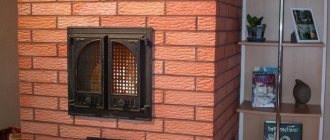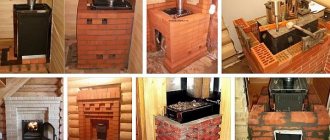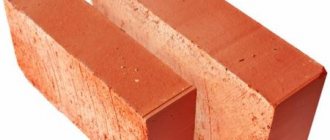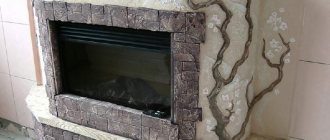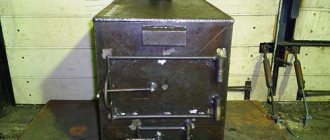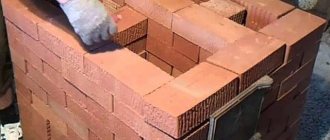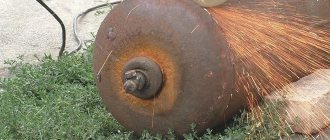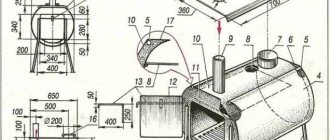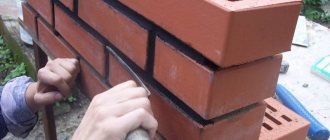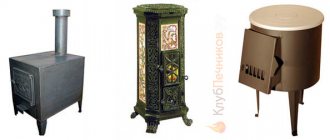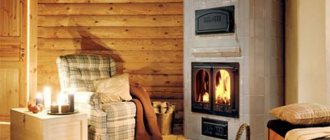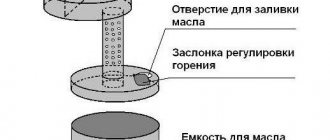Which brick to choose for masonry?
Each section of the kiln uses its own brick. The highest temperature in the firebox. The material must withstand such a load. Only fireclay bricks are suitable here.
All smoke exhaust channels and the firebox area are also subjected to a temperature test, although not so high. Here we will use fire-resistant ceramic bricks. It is cheaper than fireclay and can withstand the load.
As a base we will use frost-resistant bricks that can withstand high pressure. The weight of the entire structure will be distributed on it.
General recommendation - use brick:
- full-bodied;
- qualitative;
- with good heat transfer and heat capacity.
The bricks must have different sizes. Before purchasing, you need to clarify which order is calculated. Below are step-by-step instructions for laying a brick stove with your own hands. There you can use a brick measuring 250x120x65. Also, it is he who is taken into account in the order in photo No. 2 (below, in the section “Masonry of the stove”).
If desired, you can use various decorative types of bricks for cladding. This will give the stove a more aesthetic appearance.
In our case, you will need 60 pieces of refractory ceramic bricks and 35 pieces of fireclay bricks (including possible losses).
Secrets of the design of a potbelly stove
In general, a potbelly stove is a stove of a primitive design with a blind bottom. The minimum efficiency of this design is about 5-10%.
Pipe
A potbelly stove is the simplest stove.
An interesting detail from a technical point of view is the design of the pipe. The size of its diameter is such that it allows exhaust gases to pass through in smaller quantities than they arise during the processes occurring during combustion. This arrangement of the pipe creates conditions under which combustion products are not immediately removed, but rather make several turns in the firebox. By doing this, they contribute to the suction of additional air, which makes it possible to burn the fuel in full. After this, the cooled flue gases are discharged into the chimney.
The correct ratio of the pipe diameter, expressed in millimeters, and the volume of the firebox in liters should be around 2.7.
Screen
The design of the furnace assumes a fuel combustion mode close to partial pyrolysis. This means that the rotating flue gas streams burn out in the furnace. At the same time, the stove smoothly switches from operating in one mode to another, giving off heat during the smoldering process of the fuel.
The installation of a screen surrounding the furnace on three sides and thus covering half of its entire surface allows us to solve the problem of maintaining the temperature in the furnace and ensuring the safety of the structure. The screen is located at a distance of 50-70 mm from the stove and reflects a significant part of the infrared radiation onto it. The specified gap makes it possible to increase the efficiency of the unit.
The role of convection
Cast iron potbelly stove
The beginning of the combustion process of fuels with high calorific value, which include coal and firewood, is characterized by the release of a significant amount of energy. In this regard, there is a need to transfer a flash of heat into the room. This can be achieved using convective heat transfer. In our case, the screen traps warm air near the surface of the heated firebox and directs it tangentially along its surface. Physical laws confirm the inappropriateness of shielding horizontal surfaces.
Litter
The bottom of the furnace, called the bottom, heats up to a lesser extent compared to the walls, but intense heat radiation downwards occurs. This has virtually no effect on the power of the oven, but can cause a fire. In order to avoid this, the stove is installed on a structure consisting of a layer of asbestos or basalt cardboard on which a sheet of metal is located. The extension of the latter should be at least 350 mm around the perimeter of the furnace.
Chimney
Due to the fact that combustion products go into the chimney at a significant temperature and are not completely burned, the design of the chimney has a great influence on the operation of the stove. It consists of:
- the vertical part, the height of which should exceed 1-1.2 m. When organizing thermal insulation of this section, an acceptable gas economizer is obtained;
- hog, which is located horizontally or at some angle. It is a pipe having the same diameter. The purpose of this structural element is to create conditions for the combustion of exhaust gases. Its heat transfer is about 25% of the total heat transfer of the device. The hog should be a minimum of 2.5 m in length, and ideally more than 4.5 m.
The hog should be located at a distance of more than 1.2 m from the plastered surfaces of the walls and ceiling; for wooden cladding it increases to 1.5 m. Compliance with this requirement will not only avoid fire, but will also preserve the finish. To avoid injury, the hog must be positioned at a height greater than 2.2 m
Preparation of the solution
Let's start by preparing the solution. For masonry work we use a special ready-made mixture. Sold in construction stores. It is a yellow-gray powder in 25 kg bags. All that remains is to dilute it with water in the correct ratio and mix. Detailed instructions are always indicated on the packaging; you need to follow them step by step. This solution is the best choice. It has only one drawback - its high price.
You can prepare the mortar for masonry yourself. For this we need clay and sand. First, let's determine the quality of the available clay and the content of impurities in it. We follow the following instructions:
- Roll the clay into a rope. Thickness - 10-15 mm, length - 150-200 cm.
- Take a rolling pin with a diameter of 50 mm and wrap a rope around it.
- The tourniquet should stretch smoothly and break, stretching by about 15-20%.
Expert opinion
Pavel Kruglov
Stove maker with 25 years of experience
If the rope stretches more, the clay is “fat”; if it breaks earlier, the clay is “skinny.” In the first option, the solution will shrink greatly under the influence of temperature, in the second it will crumble.
The next step is to prepare the sand. First, sift it through a fine sieve. The cell should not exceed 1.5x1.5 mm. Next we follow the instructions:
- using a handle and burlap, we arrange some kind of net;
- pour sand into it and begin to rinse it under running water;
- Rinse until the draining water runs clear.
Thus, we have rid the sand of impurities.
We do the same with clay. Now it should be soaked. To do this, pour the clay into a previously prepared container. Pour water so that the entire surface of the clay is covered. After 24 hours, mix thoroughly. We repeat the process until the clay has a consistency similar to toothpaste.
There is no universal proportion for a solution. Everything is installed by trial and error, depending on the characteristics of the materials used. The main thing is that the solution is convenient to work with.
To increase strength, experts recommend adding a little cement or salt.
Expert opinion
Pavel Kruglov
Stove maker with 25 years of experience
Here is a basic recipe for masonry mortar:
Take 2 parts of clay. Add one piece of sand to it. Using a construction mixer, mix until smooth and thick. We will need approximately 40 liters of solution.
How to properly fold a potbelly stove?
Even a beginner can correctly assemble a brick stove-stove on his own. To do this, you need to know and follow the simple rules that pechnoy.guru will provide below.
Scheme and drawing
Below we will look at how to build a potbelly stove out of brick with your own hands. The drawing and dimensions can be seen in photo No. 1:
Photo No. 1 - do-it-yourself drawing of a potbelly stove made of brick
The sequential layout of bricks from a potbelly stove is shown in photo No. 2:
Photo No. 2 - sequential layout of bricks (diagram)
We have decided on the materials and design of the furnace, and the solution is ready. This design does not require a foundation. For comfortable and safe operation, heating must be placed in compliance with all fire safety standards. Having chosen a place, lay two layers of waterproofing. On top we make a preparation of sand, 10 mm thick. Let's start laying:
- We lay a brick on top, without mortar (see photo No. 2, first row). We strictly control horizontality using a level.
- We install the door for the blower. We secure it with wire and wrap it with asbestos cord.
- We continue laying (see photo No. 2, row No. 1).
- Next comes fireclay brick (see photo No. 2). Grate bars will be installed above it.
- We place grate bars directly above the ash pit.
- We place the next row on a spoon. We put the wall at the back without mortar (knockout bricks).
- Installing the firebox door. We secure it with wire and bricks.
- On top we place a row on the bed along the contour of the fourth.
- The next one is again on a spoon. We put 2 bricks at the back.
- The row at the top should overlap the combustion door and end 130 mm above it.
- We continue laying, moving the bricks back a little. Before this, we lay an asbestos cord on which we will install the hob.
- Let's start forming the chimney from the next row. The design provides for the installation of a mounted pipe made of tin or corrugated aluminum. The pipe should not be heavy. Otherwise, the center of gravity may shift.
- On the eleventh row we install a valve to regulate the air flow. Don’t forget to seal it with asbestos cord and cover it with clay.
- Next, we place a chimney pipe in the quadrangle, which we connect to the metal one. The pipe must stand strictly vertically and not lean to the side. For greater stability, it should be covered with three rows of bricks.
- We remove the knockout bricks that we placed on the 4th row and clean the chimney of debris.
- Now the stove should be whitened. Any lime will do. Experts recommend adding blue and a little milk. This way the whitewash will not darken and fly off.
- We install a metal sheet in front of the firebox.
- We install the baseboard.
An example of a finished brick stove
Drying
The cause of cracks is excess moisture in the bricks, so the oven must be thoroughly dried. There are two stages of drying: natural and forced.
- Natural drying lasts at least five days. All doors must be fully open. To increase the intensity of the process, place a fan in front of the firebox or stick it into it and turn on a regular electric incandescent lamp (not an energy-saving one). It will not be possible to completely dry the oven using this method, so we move on to the next step.
- Forced drying is carried out by burning dry wood. This type of fire is carried out once every 24 hours. You should only heat with small dry logs. Open the blower door slightly and open the plug halfway.
When the wood burns out, loosely cover the ash pit. Close the top plug, leaving 1-2 cm. When the coals burn out, open all channels. Carry out this fire for a week. On the first day, about 2 kg of wood is burned. Then add 1 kg every day.
Making a firebox door
This element is the most complex in the entire structure. The following table shows the standardized dimensions of oven doors:
| Size | Blower, cleaning doors, mm | Openings for fire doors, mm | |||
| length | 25 | 25 | 25 | 30 | 25 |
| width | 130 | 130 | 250 | 250 | 250 |
| height | 70 | 140 | 210 | 280 | 140 |
We make the door for the firebox according to the drawings shown in photo No. 3:
Photo No. 3 - drawing of the door for the firebox and cleaning chamber
Metal cladding
A brick potbelly stove can be additionally sheathed with metal. We will get a metal potbelly stove with all the advantages, but without the disadvantages (except for weight). This design will protect the stove from cracking and chipping. This will significantly increase service life. This will require sheet metal 4-6 mm thick. The process is not particularly difficult. The metal sheet is marked, the necessary parts are cut out with a grinder or a cutter. Next, the cladding is carried out and connected using welding and a metal corner.
This design is not only durable, but safer. However, it requires additional costs and labor.
Option two - homemade potbelly stove
If you have a welding machine, potbelly stoves, proven and simple designs, can be made in one day. To fire a potbelly stove, you can use thick-walled pipes, barrels and gas cylinders. A rectangular potbelly stove can be welded from a metal corner and steel sheets (3 mm thick).
Important rules for locating a potbelly stove in the garage
In order to avoid fire, you must follow the following fire safety rules when installing a homemade potbelly stove:
- distance to walls and flammable objects - a meter, distance to a brick wall - 0.5 meters;
- the walls and ceiling around the stove are additionally sheathed with sheets of metal;
- a thick metal sheet is placed under the stove - 10 mm or a cement screed is made - thickness 20 cm;
- It is necessary to install ventilation (forced or natural) so that if there is smoke there is no trouble. A 5 cm gap under the garage door or two exhaust vents under the roof will ensure sufficient natural ventilation of the room.
The distance from the stove to the car must be at least two meters. If you come into close contact with the hot walls of the stove, there is a risk of damage to the paint or ignition of the fuel.
An additional protective casing made of brick walls will not only create a convection flow of warm air and increase heat transfer, but also ensure safety.
Note. Only square or rectangular potbelly stoves can be covered with bricks
A furnace in the form of a cylinder requires a special design of the casing, in the form of side metal ribs. A brick casing for the cylinder will reduce heat transfer and lead to rapid burning of the walls.
How to make a simple square potbelly stove
For a standard garage, a heating device 30 x 30, 50 cm high is quite enough. The diameter of the pipe for a potbelly stove is at least 30 cm, the wall thickness is at least 5 mm. For a chimney, a pipe with a diameter of 12–15 cm and a thickness of 3 mm is suitable. To prevent the chimney pipe from quickly becoming frozen, it is wrapped on the outside with a layer of mineral wool.
Work order:
- First, we draw the cutting of the stove parts, determine all the dimensions;
- we cut out the necessary parts from sheet metal to size;
- First, we weld the walls and bottom of the oven together, but only grab them. To be able to set all sides strictly according to level;
- after checking the vertical and horizontal lines, you can weld all connections using a T-weld;
- We install the lower partition into the finished housing. You immediately need to drill holes in it to remove ash (the step between the holes is one and a half centimeters, from the walls - 5 cm);
- the partition is located no lower than 10 cm from the bottom;
- cut out a circle in the back wall to install the chimney pipe;
- firebox and blower doors - distance from the wall - 5 cm;
- when attaching the door curtains, you need to take into account that they will sag due to temperature, so we attach them 2 cm higher;
- The last to be installed are the legs of the potbelly stove - the height is at least 15 cm and the top sheet of the stove is installed.
In order to obtain maximum heat transfer, the stove pipe should not be straight. It is necessary to install pipes with two 30-degree turns and lead them through the wall of the garage. Then the combustion products will give off all the heat not to the street, but to the room.
The video shows how to make a simple potbelly stove from a metal sheet and corners and from an old gas cylinder.
Installation and connection
When installing the stove, you must strictly follow the fire safety rules:
- The distance to walls and surrounding objects must be at least 800 mm. The walls can also be covered with ceramic tiles.
- All parts of the chimney must be tightly connected.
- The room must be equipped with a supply and exhaust ventilation system.
The chimney is installed like this:
- We fix the first piece of pipe above the chimney opening.
- We increase the pipe bends to the ceiling level.
- We make holes in the ceiling with a diameter of 170 mm. We remove a layer of thermal insulation around the hole to prevent fire.
- First, we mount the pass-through glass, then insert the pipe into it.
- Next, we connect the pipes to the external chimney.
- We apply bitumen to the pipe and insulate it.
If you need to heat a large area, you can connect the stove to a heating panel. This will increase the heat flow and allow it to be retained longer.
Features of operation
Expert opinion
Pavel Kruglov
Stove maker with 25 years of experience
The operation of such a stove is similar to a conventional brick stove. Although it does not retain heat so well. Therefore, a brick potbelly stove made with your own hands will have to be heated again 4-6 hours after the last coals have burned out.
This indicates the unprofitability of using such a design for constant heating. However, for heating a garage, cottage, etc. periodically, it may well be used.
This stove runs only on solid fuel. This is another drawback.
At the same time, the design is simple to manufacture and operate. This is what determines its popularity.
Potbelly stove lined with brick
It should be understood that, in principle, no two potbelly stoves can have the same design, which is why there are many masonry options. Before covering a potbelly stove with bricks, you need to familiarize yourself with and adhere to the general rules for performing such work.
Brick laying is carried out with a distance from the walls of the metal stove, which is 100-150 mm. The top and bottom parts of the masonry must provide openings for ventilation.
When the air located in the gap between two structures is heated, air masses circulate. Warm air moves into the room. Cold air, moving along the walls of a metal potbelly stove, cools it, which helps to increase the service life of the device.
Potbelly stove lined with brick
Conclusion
It is quite possible to make a brick potbelly stove from bricks yourself. Such a furnace increases efficiency from 50-60% to 70-75%. However, it is still not cost-effective enough to fully replace stove heating. Although it retains heat more efficiently than iron, it requires the connection of a heating panel for constant use.
As a temporary source of heat, a brick potbelly stove, made with your own hands in a garage or greenhouse, is fully justified.
The design can be further improved by clad in metal. This will increase the service life and protect the stove from damage.
Cast iron potbelly stove lined with brick
The characteristics of cast iron are such that potbelly stoves made from it do not require shielding. The heat capacity and thermal conductivity of cast iron structures is higher than that of steel products, but they are not without the already mentioned disadvantages.
Cast iron potbelly stove has greater thermal conductivity
Bricklaying
In this case, the work is somewhat simplified, since there is no need to organize a foundation for an installed cast-iron potbelly stove. Fundamentally, the ordering is no different from the process described above.
small-house.ru
